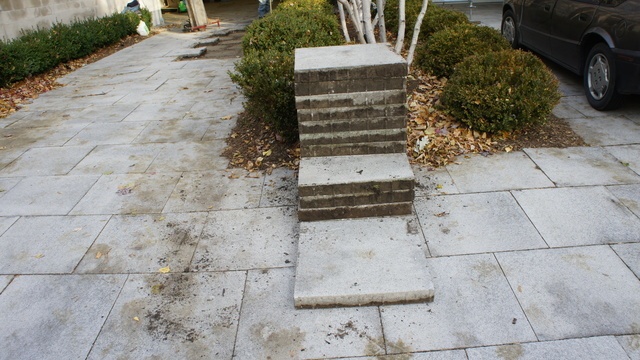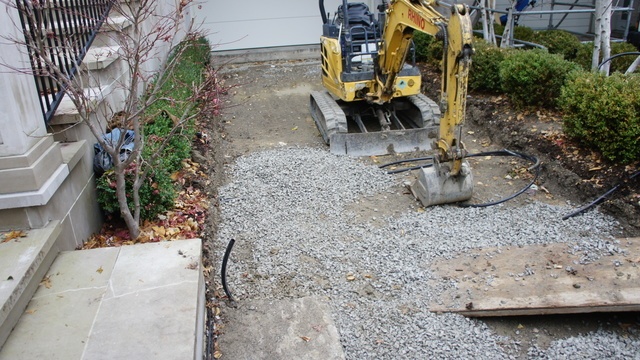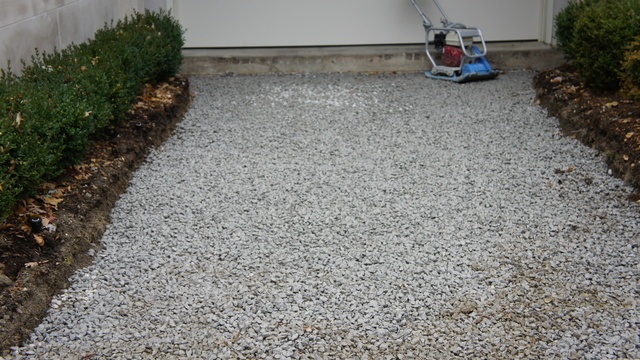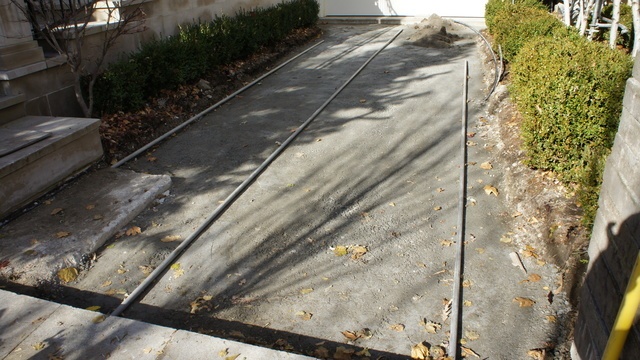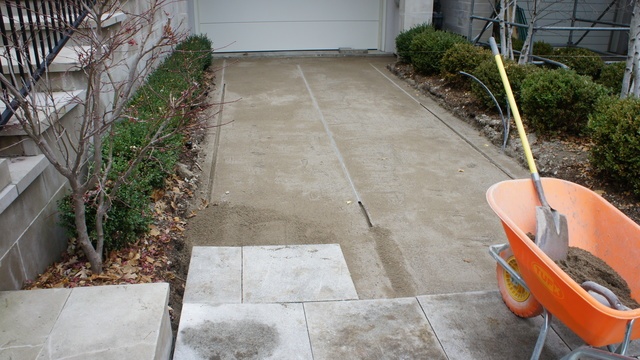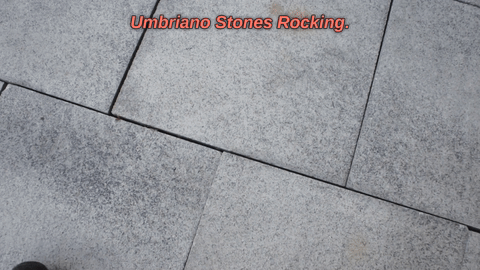 I always enjoy going out and meeting with homeowners and discussing their projects with them. It’s always fun talking about their hopes and dreams for a certain area, whether it be a new front entrance, driveway or backyard patio. The goals for these projects are usually very personal and it’s a process to come up with ideas or a design to solve specific problems, than to work through the material selections. This project was a little less visionary but just as important to this homeowner, getting their driveway fixed and not having to go through the same process two or three years from now.
I always enjoy going out and meeting with homeowners and discussing their projects with them. It’s always fun talking about their hopes and dreams for a certain area, whether it be a new front entrance, driveway or backyard patio. The goals for these projects are usually very personal and it’s a process to come up with ideas or a design to solve specific problems, than to work through the material selections. This project was a little less visionary but just as important to this homeowner, getting their driveway fixed and not having to go through the same process two or three years from now.
The homeowner on this project simply wanted to have a driveway that didn’t rock. But isn’t that what we really want? We all want driveways that rock. When people walk by, they give us compliments, hey, your driveway rocks! That sounds like a pretty good position to be in. That’s not exactly the correct description for this driveway, when I was looking at this driveway, the large Umbriano stones, 24”x24”, didn’t look right (see picture below). One stone was sticking up about 1”, I put my foot on one corner and pressed down with my foot, I watched the other corner rise up. I repeated this motion several times and this large stone rocked back and forth like a teeter totter. (see pictures below)
 Wobbly Umbriano DrivewayThis interlocking paving stone driveway installation has failed. See below on how we fixed it.
Wobbly Umbriano DrivewayThis interlocking paving stone driveway installation has failed. See below on how we fixed it.
 This joint size is too bigThe Driveway's gaps started to open up. The Umbriano stones began to creep out towards the edge.
This joint size is too bigThe Driveway's gaps started to open up. The Umbriano stones began to creep out towards the edge.
 Not very levelThe driveway also started to become quite unlevel. Some stones had a 1" height variation.
Not very levelThe driveway also started to become quite unlevel. Some stones had a 1" height variation.
 Ineffective edge restraintsThe edge restraints used here do not work in freeze thaw climates like we have here in Toronto.l
Ineffective edge restraintsThe edge restraints used here do not work in freeze thaw climates like we have here in Toronto.l
 Ineffective edge restraintsThere is such a large gap between the paving stone and the edge restraint, what exactly are these restraining. Answer, not much.
Wobbly Umbriano DrivewayThis interlocking paving stone driveway installation has failed. See below on how we fixed it.
Ineffective edge restraintsThere is such a large gap between the paving stone and the edge restraint, what exactly are these restraining. Answer, not much.
Wobbly Umbriano DrivewayThis interlocking paving stone driveway installation has failed. See below on how we fixed it.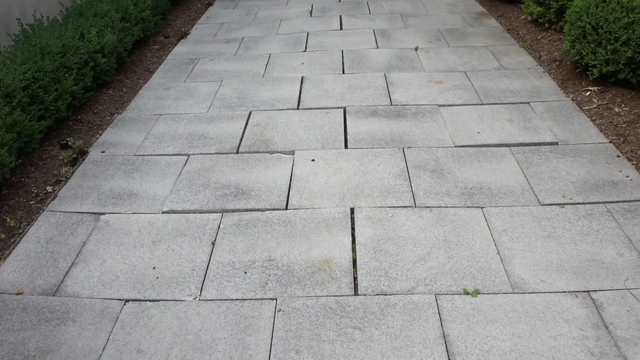
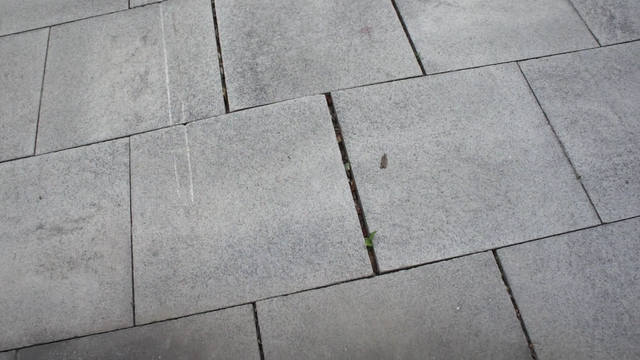
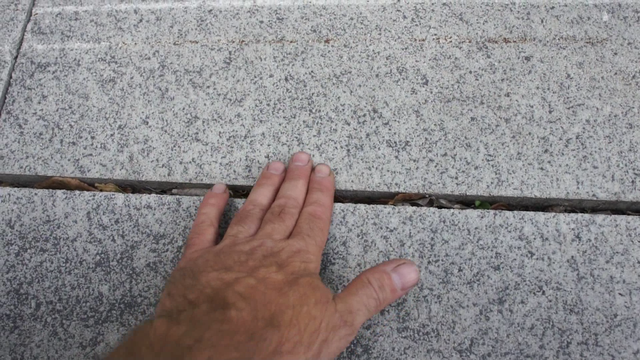
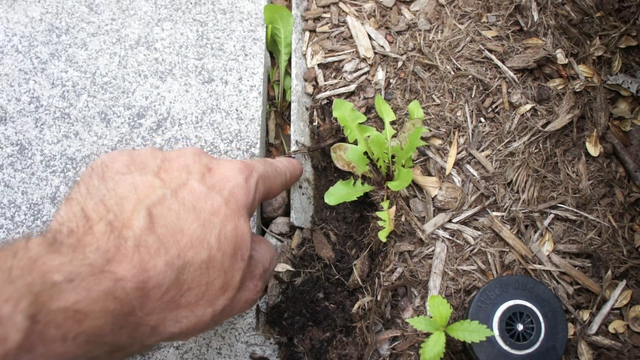
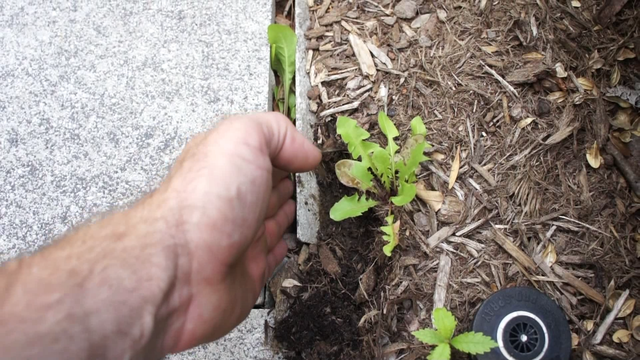
There’s no way these stones would have been installed this way. I’m sure when they were installed they stones were put in level, what happened? This pavement installation would definitely be in the failure category. This installation was about 5 years old and this driveway was already fixed once. I had to put my sherlock Holmes hat on and start investigating. After some investigation the root cause for this failure really comes down to not following the industry’s published best practices.
Problem #1 Edge Restraints
If you look at the pictures above I included one of the edge. The previous installers used a mortar edge, with our freeze/thaw climate they become ineffective within a few seasons. The proof is in the pudding as they say and this type of edge restraint simply doesn’t work long term. Edge restraints that work well long term are poured in place concrete curbs or a plastic edging. We prefer Snap-Edge and have had excellent results with it.
Problem #2 Limestone Screenings/Stone Dust
After the edge restraints failed on this driveway the Umbriano stones started to creep out towards the edge. The joints increased in size and any joint sand was washed away. What happens at this point is rather interesting and I haven’t seen a driveway in such a short amount of time react quite this way. When the joints start to open, excess water will work it’s way in the the base material. The base will become supersaturated and the fines/dust will start to be squished out. This is usually referred to as, ‘pumping out the fines.’ As the fines in the bedding layer start to get washed away with repeated vehicular traffic this will cause a depression on either end of the paving stones. There is no vertical interlock and as time passes the paving stones will start to rock back and forth as in the picture above. Here is a video I shot, showing the problems as described.
Now that we know the problems, how do we fix this?
After consulting with the client, two options were presented. The first option presented was to do a simple repair, consisting of pulling up the stones, levelling the bedding layer and re-installing the pavers and also replacing any broken or heavily chipped stones. And let’s not forget installing edge restraints that work in freeze thaw climates. Option two was the one actually given the green light, the more expensive of the two options. Option two consisted of pulling up the Umbriano stones, setting them aside digging out all the old material and replacing it with something very different.
Ultrabase - The hero of the day
After the stones were set aside, approx 12” of material was removed from the site. Approx 2” - 3” or ¾” clear stone was brought in, compacted and leveled. After this step, our hero arrived. Ultrabase/RCC. I have a full article on just what Ultrabase is, I have that here. In short, this base material is similar to gravel but contains portland cement and an air entrainment additive, it’s not concrete but it’s not gravel either. This base material is perfect for single car width driveways where deformation from tire tracks (rutting) are a problem, especially with the heavy clay soils in Toronto. We have been using this material with great success over the past several years. I’m not saying we’ll never install a traditional base for our driveway installations but Ultrabase is slowly becoming our go to solution for interlocking paving stone driveways in Toronto.
Lessons learned - The Last Word
With the advancements of interlocking paving stones in terms of colour, textures and design within the last 10 years. Advanced base techniques using Ultrabase and/or geosynthetic products. Great edge restraints and some pretty incredible advancements in polymeric sand, Interlocking Paving Stone Driveways are making a comeback. Beauty and longevity can be achieved. Still, with all these great products it all comes down to the installation. This is as they say where the rubber meets the road. Use of the industry best practices is a must, experience and a proven track record are a good place in choosing a contractor.
Paving Stones: Unilock Umbriano , Winter marvel 24” x 24”
Edge Restraint: Snap-Edge
Ultrabase: Parkview Building Supplies, Toronto
Polymeric Sand: Unilock/Techniseal RG+
Location: Toronto
 Heavy 2' x 2' stonesThis is where we stored all the driveway stones until reinstallation.
Heavy 2' x 2' stonesThis is where we stored all the driveway stones until reinstallation.
 It's time to digWe removed 12" of material.
It's time to digWe removed 12" of material.
 Stone base4"' of 3/4" clear/open graded stone was installed over the compacted soil subgrade.
Stone base4"' of 3/4" clear/open graded stone was installed over the compacted soil subgrade.
 Ultrabase installed6" of Ultrabase was installed and compacted. Pipes are installed, ready to screed.
Ultrabase installed6" of Ultrabase was installed and compacted. Pipes are installed, ready to screed.
 Heavy 2' x 2' stonesScreeding the concrete sand is complete. Let's install some of those heavy 2' x 2' pavers! We used a vacuum clamp to install the stones.
Heavy 2' x 2' stonesThis is where we stored all the driveway stones until reinstallation.
Heavy 2' x 2' stonesScreeding the concrete sand is complete. Let's install some of those heavy 2' x 2' pavers! We used a vacuum clamp to install the stones.
Heavy 2' x 2' stonesThis is where we stored all the driveway stones until reinstallation.